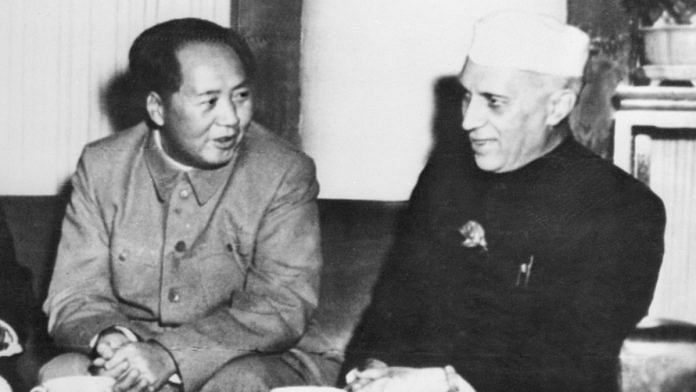Thank you dear subscribers, we are overwhelmed with your response.
Your Turn is a unique section from ThePrint featuring points of view from its subscribers. If you are a subscriber, have a point of view, please send it to us. If not, do subscribe here: https://theprint.in/subscribe/
Tibet was the root-cause of the India-China War in 1962 as the Chinese perceived that the CIA was taking Indian help for covert operations in Tibet. In early 1900s Lord Curzon who was the Imperial Viceroy of India, wanted to see Tibet as a sovereign country, it was he who had brought up for the very first time in history the question of Tibet’s total independence. For him suzerainty was ‘constitutional fiction’. In 1904 the Treaty of Lhasa was signed. The most notable thing was Tibet would deal with India not via the Chinese Government. However, the British Government in London was unhappy with the ideas and moves of Curzon. In 1906 a Convention between Great Britain and China was signed, Article 2 of the Convention did reaffirm China’s suzerainty over Tibet. But in 1911 Tibet rebelled as Dr. Sun Yat-Sen, leader of the Chinese Nationalist Party, did topple the Qing dynasty in Beijing, this was followed by the 13th Dalai Lama (predecessor of the present Dalai Lama), who declared Tibet as a sovereign country. But as far as the Chinese saw it, for them suzerainty meant ‘Chinese sovereignty with Tibetan Autonomy’. Suzerainty meant a sovereign country which does exercise political control over a country dependent on it. In 1950 when the Deputy PM of India, Sardar Patel learned through his sources (Patel was in-charge of the Ministry of Home Affairs that housed the Intelligence Bureau) that China had invaded Tibet, Patel wrote Nehru a letter on 7 November 1950 proposing to protect Tibet. Patel listed ten points, but in it, two were most important, this included having a firm policy on McMahon Line as well as blocking China’s entry to the UN as a replacement for Taiwan. Early on, without attempting to agreeing with Sardar Patel, Nehru declined a US offer for India with respect to UNSC veto holding seat vacated by Taiwan, after China dislodged it. Chinese Army (PLA) once it had invaded Tibet, it led to freedom movement by the Tibetans. However, there were some attempts of opposition demonstrated by Tibetans with help from CIA, to harass the PLA. The CIA project of Tibet had the goal to keep the political concept of a Tibet functional with autonomy completely alive. For the Chinese, when it came to the India-China border, their issue had not been of the border dispute during the early 1950s and middle of 1950s. But that of India’s perceived goal in Tibet. China started talking of a border dispute only in late 1950s. It was a meeting in 1959 that the Chinese Communist Party made a decision in leadership of Mao Zedong that they will wage war to teach India a lesson, and in particular Jawaharlal Nehru. Bertil Lintner’s book of 2017 ‘China’s India War’ says by arguing that Nehru’s Forward Policy was not the real trigger for war in 1962. So, in theories of International Relations, Lintner countered Neville Maxwell’s book of 1970 ‘India’s China War’ which lays the blame completely on Nehru’s doorstep by arguing that Forward Policy was the trigger of war in 1962. As far as the issue of Dalai Lama taking refuge in India during the year 1959 was concerned, that did not have a bearing on India’s Tibet Policy, simply because with the Panchsheel Agreement of 29 April 1954, India gave away all the leverages it had over Tibet that too in return for no assurances from the Chinese be it the border of Ladakh and the McMahon Line. When Indians speak of Ladakh, it automatically implies the 38000 square kilometers of Aksai Chin is an integral part of India (Ladakh). As a part of an optical illusionary friendship (this was a Nehruvian ecosystem mindset, as Mao’s China was an expert in the game of psy-ops or what is generally called deception) India and China signed the Panchsheel Agreement. Nehru was India’s first Prime Minister, and he was burdened by the gigantic refugee crisis due to the partition of the subcontinent (one new country was invented by Muslim League in India, West Pakistan and East Pakistan). All this since 15 August 1947 (and sometime before this date too) had led to horrific communal riots between Hindu and Muslim Communities, killing one million people. This all culminated in a major refugee crisis. Along with this Nehru had to address economic distress of farmers, large parts of India living in extreme poverty etc. Therefore, due to such circumstances Nehru was unable to spend on defence of India, as he thought that doing so will derail the economic prospects. It was only after the 1962 war that India seriously started working on its defence capabilities. China will remain permanent enemy of India as China wants unipolar Asia (with itself dominating), while India wants multipolar Asia.
These pieces are being published as they have been received – they have not been edited/fact-checked by ThePrint


